Digitrax Chief IIBy Michael Benolkin | 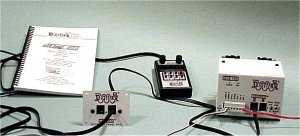 |
Background
Over the last year, I've been exploring the different technologies available for Digital Command & Control (DCC). For my first experience, I was amazed at what I could do with the MRC Command 2000 station that I picked up second-hand. At last I could take a decoder-equipped engine and run it head-on into a non-decoder-equipped engine (okay, so I watched too much Adams Family growing up!).
But as I drew deeper into the capabilities out there, I discovered the limitations of the Command 2000. While the specifications state that the system will control 10 engines, in actuality, it can address 10 engines and control only three. Two more were possible with the optional plug-in walk-around controller. The system could also control a simple on-off function, usually the engine's headlight. Believe it or not, this is a simple way to venture into DCC without much investment, but you can quickly outgrow it if you're not careful.
Hail to the Chief
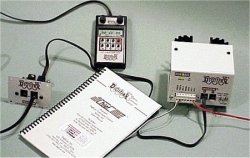 The Chief II is the current top-end product from Digitrax. It is a combination of four basic Digitrax products: The DCS100 Command Booster, the DT300 Controller, the UP-3 Front-Panel Connector and DH142 decoder. Also included is an excellent instruction book and technical manual. The one thing you will need is a 12 volt 5 amp power source to power the Chief II. Interestingly enough, the one that was recommended is the one I was using for the MRC Command 2000 - the MRC Twin Box.
The Chief II is the current top-end product from Digitrax. It is a combination of four basic Digitrax products: The DCS100 Command Booster, the DT300 Controller, the UP-3 Front-Panel Connector and DH142 decoder. Also included is an excellent instruction book and technical manual. The one thing you will need is a 12 volt 5 amp power source to power the Chief II. Interestingly enough, the one that was recommended is the one I was using for the MRC Command 2000 - the MRC Twin Box.
First, let's take a look at the differences between my Command 2000 and the three current Digitrax packages. As the table below summarizes, there are a few differences.
| MRC Command 2000 | Digitrax Genesis II | Digitrax Empire Builder II | Digitrax Chief II | |
| Max Engine Nr | 9 | 98 | 9000 | 9980 |
| Speed Steps | 28 | 128 | 128 | 128 |
| Functions | 1 | 6 | 9 | 9 |
| Simultaneous Control | 3 (5) | 22 | 22 | 120 |
| MU Capabilities | 0 | 0 | 22 | 120 |
The maximum engine number refers to what the highest number you can assign an engine. As most of the larger railroads use four-digit numbering, you'll want to program your decoder to use the same number that is painted on the side of your engine. Keeps the hassle of sorting out addresses to a minimum. The Command 2000 only uses single-digit addressing and address 0 is reserved for non-decoder-equipped engines. That only leaves 9 engines that can be discretely addressed.
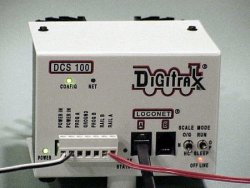 The Genesis II supports two-digit numbering, but for whatever reason, the highest address is only 98. Address 0 is reserved for the non-DCC engines. The Empire Builder is a four-digit address system, but only goes to 9000. This is fine for modeling smaller railroads, but UP, ATSF and others have engines assigned numbers above 9000. That is where the Chief comes in, it can currently go to 9980.
The Genesis II supports two-digit numbering, but for whatever reason, the highest address is only 98. Address 0 is reserved for the non-DCC engines. The Empire Builder is a four-digit address system, but only goes to 9000. This is fine for modeling smaller railroads, but UP, ATSF and others have engines assigned numbers above 9000. That is where the Chief comes in, it can currently go to 9980.
Speed steps are another issue. The Command 2000 supports 28 speed steps. This means that you can assign 28 steps on a power curve to simulate the acceleration/deceleration of a given engine. These speed steps are assigned by you (or you can use the defaults) and are stored in the decoder for that engine. Quite honestly, 28 speed steps is more than enough for me and most folks, but many of the new decoders are capable of up to 128 speed steps. You'll want to be able to use these capabilities. All of the Digitrax systems are 128 speed step capable and support decoders with fewer speed steps.
Functions are a more critical issue. Many of the newer decoders, especially the sound-capable SoundTraxx decoders, use the various functions for standard headlights, MARS or Gyralights, ditch lights, Flashing ditch lights (when horn sounds), bells, horns, and engine sounds. Quite frankly, these decoders will work with the Command 2000, but you won't be able to use the special effects. The Genesis II will control most standard controllers, while the Empire Builder II and Chief II will be able to handle just about anything that you can put on the rails.
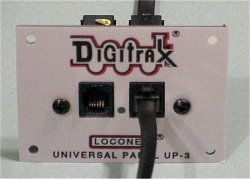 On smaller home layouts, simultaneous cab numbers are not very critical. If you think you'll have more than two operators running on your layout, you'll be ready to step up into one of the Digitrax offerings.
On smaller home layouts, simultaneous cab numbers are not very critical. If you think you'll have more than two operators running on your layout, you'll be ready to step up into one of the Digitrax offerings.
A relatively new feature is MU consisting. This is where you can put two powered F7As and two powered F7Bs (all decoder equipped) into a 'consist' which is a logical engine that has a unique address that allows for simultaneous control of all four engines from one controller. This is where the speed step functions come in handy. You can have a pair of Athearn F7Bs matched with an MRC F7A and Genesis F7A. You use the speed steps to match the acceleration/deceleration capabilities of each engine so they will operate as one. This is a very cool capability!
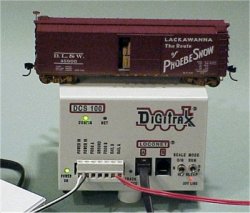 Parts is Parts
Parts is Parts
The reason I jumped to the Chief is to get access to all of the addressing and function control capabilities. When I opened the box, I was expecting to see something the size of the Command Station 2000 (or larger). Instead the DCS-100, which is the brain of the system, is very small and intended to be stashed somewhere under the layout. I placed an HO 40' boxcar on the DCS-100 just to illustrate the size (or lack thereof).
The UP-3 front panel allows you to plug one or two controllers into the system at that point. On larger layouts, you can daisy-chain any number of UP-3s and move around the layout, plugging from one UP-3 to the next.
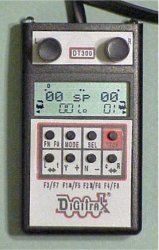 The DT300 controller is a compact device that provides simultaneous control of two engines as well as the ability to address any engine on the line. This controller is soon to be replaced by the DT400, which has a larger display and improved control features. Both controllers also offer infrared or wireless radio control capabilities, allowing you to walk around the layout without any tethers. Not bad.
The DT300 controller is a compact device that provides simultaneous control of two engines as well as the ability to address any engine on the line. This controller is soon to be replaced by the DT400, which has a larger display and improved control features. Both controllers also offer infrared or wireless radio control capabilities, allowing you to walk around the layout without any tethers. Not bad.
Conclusions
Digitrax is one of several leading manufacturers of intermediate-advanced control systems and decoders in the model railroading market. Names such as Lenz, North Coast Engineering and System One are also in this category. The products from any of these manufacturer are definitely worth a look and will provide you with loads of fun. The differences between them are in the details, though a decoder from any of these manufacturers (as well as others) will work with these command stations. Some adhere closely to the NMRA DCC standards, while others support the basic standards and have added a few tricks of their own.
The Digitrax systems are reasonably priced, but with a little shopping around, you can do even better. For instance, the Chief II has an MSRP of $460, but you can buy it for $354 at Tony's Train Exchange (www.ttx-dcc.com). I am sold on the Chief and we'll be using it to evaluate and upgrade engines using a variety of decoders in the coming months.
My sincere thanks to Tony's Train Exchange for the use of their Chief II!







